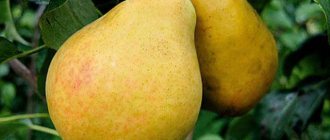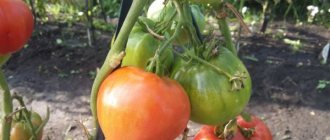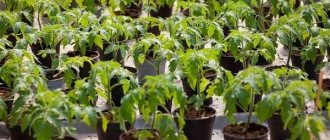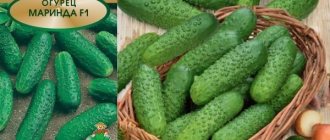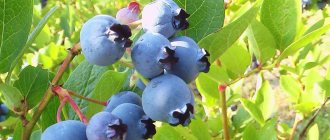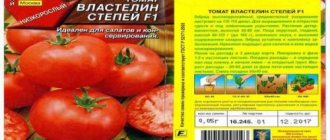| Name | Variety Zest | Berry color | Dark pink |
| Selection | Institute "Magarach", Yalta, (Chaush x Cardinal) | Bunch weight | 400-500 g. |
| View | Dining room (delicious food) | Sugar content | Brix 15-17 |
| Ripening time | Early (110-120 days) | Bushes | Very vigorous |
| Frost resistance | Low | Sustainability | Low |
| Productivity | Average and below average | Presence of a bone | Present |
Description of the variety
The highlight is an early ripening table grape variety selected by the Magarach Institute. The calling card of the variety is early ripeness and very beautiful elongated pink berries. Pollination ability of Izyuminka is very good, especially considering that the flower type of the variety is functionally female. But what the variety does not shine with is its yield, and there are several reasons for this. Firstly, Izyuminka has a very low fruitfulness of shoots; it is recommended to carry out only long pruning, so that it is possible to normalize the shoots already with inflorescences and at this stage remove all the fruitless ones. The second problem is small bunches, no matter how we ration, leaving even 2 bunches for shoots, we still won’t get a total large harvest. Another problem is growing Izyuminka in the Moscow region, the Urals and Siberia. To set fruit buds, you need high SAT indicators, and they can only be achieved in the south, so the variety is suitable for the Crimea, Krasnodar Territory and Rostov Region, but not for more northern regions.
As for the taste, Izyuminka’s taste is excellent - there doesn’t seem to be a lot of sugar, but the acidity goes away very quickly, resulting in a very pleasant dessert taste. The pulp is very juicy, the skin is thin, you can’t feel it when eating.
As for resistance, Izyuminka does not shine here, it quickly picks up mildew, and it does not shine with resistance to oidium. Three preventive treatments are often not enough for her.
Conclusions: I would not recommend novice winegrowers to plant Izyuminka. This is a variety for professionals who want to tinker with the variety, prove something to someone, show that you can’t do anything, and I even tamed Izyuminka. And for a beginning winegrower, problems with diseases, single shoots, and pollination from other varieties are just an extra headache.
In the conditions of Novocherkassk, Rostov region, Izyuminka ripens in the first ten days of August.
Bushes
- very strong growth force;
- functionally female type of flower, requires planting pollinator varieties;
- problems with vine ripening on young bushes;
- good rooting of cuttings;
- low fruitfulness of shoots;
- Long pruning of fruiting vines with 10-12 buds or more is recommended, followed by removal of fruitless shoots.
Berries
- dark pink;
- elongated, finger-shaped, some saber-shaped;
- medium size (10-12 g, 34 x 17 mm), some specimens are larger - up to 4.0 cm in length or more;
- the flesh is dense, fleshy, crispy;
- The skin is thin and cannot be felt when eating.
Bunches
- cylindrical;
- moderate density;
- with an average weight of 400-500 g and larger in powerful formations.
Tasting assessment of fresh grapes Zizinka 8.1-8.4 points.
Taste
- refreshing, dessert;
- The sugar accumulation is low, but the acidity is also very low, so the overall result is a very pleasant taste.
The best results with Zest are obtained on large horizontal formations, arches and arbors.
Beautiful outside and inside
Raisin grows on tall bushes. It is attractive in appearance with its weighty conical clusters with equal-sized elongated bright berries, painted in all shades of red-burgundy. No less tempting is the unique, delicious taste of juicy fruits with dense, sweet pulp that is both marmalade and crunchy.
General view of ripening grapes of the Izyuminka variety
Landing
When planting, it is necessary to form a hole with dimensions of 60x60x60 cm. A prerequisite is the preparation of a nutrient mixture for filling (the composition is indicated in the picture below). We pour 15 cm of the mixture into the hole, then lightly sprinkle it with soil so that there is no direct contact of the roots with the fertilizer, install the seedling, sprinkle it again with soil and then 15-20 cm of the nutrient mixture with soil. Water with two buckets of water.
Thus, deep planting is carried out, making it possible to effectively protect the root system from frost and in the future to form bush sleeves from the ground. It is recommended to shade vegetating seedlings for the first two weeks using agrospan.
Planting on the north side of buildings and fences is not allowed. It is required to maintain a distance from large trees of 4 to 6 m. It is best to plant on a southern slope or an area protected from the north by a fence or buildings. In this way, it is possible to provide protection not only from the cold northern wind, but also to ensure that the walls or fence screen the sun's rays into the vineyard; in addition, the walls heat up during the day and gradually release heat at night, thereby leveling out temperature changes. Groundwater should be located no closer than 1.5 m from the surface.
The distance between bushes in a row is 2.5 m, row spacing is also 2.5 m.
Hole dimensions: depth 60 cm, length and width 50 cm.
Composition for filling the hole:
Growing Zest
When deciding to grow Izyuminka grapes on your own plot, you must carefully weigh all the positive and negative characteristics of this variety and take into account all the nuances of its cultivation.
When choosing a place to plant Raisin, you cannot miss its reduced frost resistance. It can survive at temperatures of -12–18 ºС, some sources indicate that up to -20 ºС. This means that it must be placed in the warmest and sunniest place - on the south side of the building or structure and at a distance of at least half a meter from them, so that the roots of the plant do not suffer during frosts. For the winter, Izyuminka needs shelter from severe frosts and insulation of the root system.
Only female type flowers appear on the vines of the Raisin. For pollination nearby, early grapes with male flowers are definitely needed. Overall, it pollinates well.
Although Izyuminka is a tall grape, it is recommended not to prune it for the first two years. In the future, when pruning these vines in the fall, it is better to leave 10–11 buds on each, and 40–45 buds for the entire bush.
The first harvest can be expected in the third or fourth year after planting. The next few years it will be small - 2-3 kg from each bush. Gradually it can be increased to 7–8 kilograms.
Considering the low resistance of Izyuminka to many diseases, and also in order not to expose it to the danger of pests, it is necessary to strictly and constantly observe the timing of treatment of grapes with chemicals, fungicides and insecticides. Carry out all necessary agrotechnical measures carefully and in a timely manner.
Growing and care
Watering
If we consider classic watering schemes, then the bushes are watered for the first time immediately after being placed on the trellis (if the soil is not wet after the snow melts), water the second time a week before flowering, then 2 times while the berries are in pea state, at the end of the season, before During frosts we carry out water-recharging irrigation. We try not to water the grapes during flowering, water minimally when the berries are coloring and in general after August 1, in order to stop the growth of green mass and so that the vine ripens faster.
If we do not water through a drop, then it is very convenient to make pits with sides made of earth around the bushes. The height of the earthen sides is about 10 cm. We fill the pit with water until the water begins to overflow over the sides, so the bush itself regulates the required volume of water.
We water young bushes more often than adults, but in a smaller volume, for example, one-year-old bushes need to be watered weekly, but literally 1-2 buckets per bush, we water an adult bush once every 2 weeks, but sometimes 100 and 200 liters of water are used. I don't ration water. I put the hose in the pit and water until the water begins to overflow over the sides of the pit.
Feeding
The basic rule of fertilizing is to provide the grapes with nitrogen in the first half of the season, and in the second half with potassium and phosphorus. The first component is required for the active growth of green mass, and potassium and phosphorus for good ripening of the vine and good taste.
At the beginning of summer, the lack of nitrogen can be compensated by using mullein. To get it, you can mix a bucket of fresh cow dung with a similar volume of water. During watering, you need to add 2-3 buckets to the pit, which is arranged for watering.
From August 1, it is necessary to take care of the ripening of the vines. Nitrogen is no longer used, but it is necessary to compensate for the lack of potassium. Feeding is carried out according to the leaf. The concentration should be between 40–50 g per 10 liters of water. After seven days, you need to dilute 50–60 g per 10 liters of water. Thus, the concentration should be gradually increased until it reaches a limit of 120 g.
Processing by leaf in May. Nitrogen content 30%
Processing by leaf in June. A large amount of phosphorus stimulates the formation of a large number of inflorescences
Since August 1st we have been using the 5:15:45 train. The minimum amount of nitrogen will not allow the shoots to fatten, the vine will ripen well
Treatment against diseases and pests
Zest has low resistance to mildew and oidium, so it simply needs preventive treatments. Moreover, fungi usually appear closer to harvest, and at this time the use of chemicals is strictly prohibited.
We spray the grapes 3 times - when 4-5 leaves appear on each shoot, before flowering and when the berries are at the pea stage. There are many processing tools, one of the options is:
- a solution of 1% Bordeaux mixture, I also add Ecosil to it, but you don’t have to add it;
- tank mixture of preparations: Falcon 5 ml./10 l. and Ridomil Gold 25 g/10 l.;
- I repeat the preparations from the second treatment or spray with the preparation Strobi, it immediately removes both mildew and oidium.
Ticks are a rare occurrence in my area. If you are fighting mites, for example, on strawberries, then they can also spread to grapes; you should add Actellik, Fufanon (10 ml/10 l.) or any other acaricide to the tank mixture. In warm weather, you can do without chemicals - treat the bushes with Fitoverm.
Mildew
Oidium
Mite
Pruning, green operations
Pruning during the season is a very important agricultural practice.
We pinch out all the shoots on the bushes. It is better to pinch the stepson rather than break it out; on some early varieties, when breaking it out, a bud wakes up, but we need it to bloom the next season, so we simply cut off the stepson above the first leaf on it (shown in the picture).
As soon as the shoots reach the top wire, we cut off their top, leaving 2 sheets above the top wire of the trellis (for me it is 2.4 m). The so-called chasing will stimulate the ripening of the crop and vines, and will prevent the creation of thickening at the top in which mildew and oidium can very quickly develop. We repeat the minting every 10-14 days, because... the growth of stepchildren and stepchildren of the second order will begin. We also delete them.
We carry out rationing by shoots. Izyuminka has a known problem - a large number of single shoots, so it is better to wait until inflorescences appear and then remove excess shoots so that there is a distance of at least 15 cm between adjacent shoots.
Zest produces small clusters, so you can leave 2 clusters for the shoot. However, if you see that you have heavily loaded the bush or your variety always shows large clusters, then leave 1 cluster for each shoot. So the ripening dates will not shift and next year the bush will leave without weakening. Leaving a small harvest is also bad, the vine can fatten, there are no clear recommendations in what volume to load this or that bush, it all depends on the condition of the bush, place of growth, conditions.
Shaping, trimming
Briefly about the formation:
- In the first year, we grow one shoot from the seedling, removing all the stepsons, and in the fall we prune it back to growth, leaving 3 buds;
- In the second year, shoots will begin to develop from the buds; we remove the shoots on them during the season, and trim them in the fall, keeping in mind that these shoots will act as sleeves and you will place them on the trellis wire next season. That. you don’t need to leave them very long, otherwise one bush will overlap another, for example, there are 2.5 m between the bushes and you want to place the sleeves towards each other, which means they should reach just one to the other, 1.25 m for each bush, cut it that way.
- In the third year, we place the sleeves grown last year horizontally on the bottom wire, vertical shoots will grow on them and the first harvest will begin; also, several more sleeves need to be grown from the head of the bush this season.
- In the autumn of the third year we inspect each sleeve, our task is to leave only one vertical shoot, it will be the growth of the sleeve, it is desirable that this shoot be closer to the head of the bush, otherwise in a few years it will simply be impossible to bury the sleeves, they will be very long. All shoots and part of the sleeve coming after the left shoot are removed. We carry out this operation year after year.
Shelter for the winter
They cover Izyuminka for the winter in most of Russia. The materials used to create a “winter coat” are sawdust and spruce spruce branches and spunbond with polyethylene (definitely not!), I chose the most economical method for myself - I cover it with earth. Mice can breed under the covering material; there is a risk that the vine will dry out in the spring; you have to open it early, and this risks getting subject to return frosts.
When to cover and open the grapes: we bury them after several small frosts, the vine should harden a little, in the spring we dig them up when warm weather sets in, when there are no longer negative temperatures in the forecast for the next 10 days. Thickness of earth cover: 10-15 cm.
History of selection
The Izyuminka variety was developed at the Ukrainian Institute of Grapes “Magarach” relatively recently. It was obtained by crossing the Chaush and Cardinal varieties, and has a second name XVII-241.
It is no coincidence that this variety is called a highlight. Its berries have an amazing property: if you do not remove them from the bush for a long time, they do not overripe or rot, but wither and turn into raisins right on the vine.
Karmakod, Russian Korinka and Kishmish Stoletie are also good for raisins.
This variety is zoned in Moldova, Ukraine and southern Russia. It is recommended to grow only in warm climates and with obligatory shelter for the winter.
Reproduction
During autumn shaping, a lot of vines are cut out, which is the planting material. We cut the vine into pieces so that each has 3 buds, put it in a cellar, basement or refrigerator, germinate it in March, when the weather is warm, transplant it into open ground. More details about storage and germination of cuttings are indicated in our separate articles.
The second option, when you need to get literally several new plants, is to make layering. To do this, a hole measuring 40x40 cm and a depth of a shovel is dug next to the bush, nutritious soil from black soil, rotted manure and sand (1:1:1) is laid in it, an annual growth of a powerful but non-fatifying shoot is pinned into the hole, in Where placed in the hole, all leaves are removed and scratches are made with a knife, the hole is filled with 10-15 cm of nutritious soil on top, which is kept moist. Read more about this method here.
Disease and their description
Diseases that easily affect the Izyuminka variety:
- mildew;
- bacterial cancer;
- gray rot;
- oidium;
- anthracnose;
- escoriosis.
The variety is also susceptible to attack by harmful pests:
- grape mite;
- spider mite;
- phylloxera.
Description of disease control
Mildew attacks grapes of this variety very quickly.
If, nevertheless, the bush was affected, then the infected leaves must be removed and treated with fungicides. But you shouldn’t hesitate, because this disease is one of the most common and dangerous for vineyards. It can lead to the destruction of crops and even vineyards.
To prevent this, it is necessary to carry out bardic liquid treatments of the bushes at least three times during the season. It is also best to use phosphorus-potassium fertilizers for fertilizing.
Bacterial canker often forms in areas where the vine is damaged in a large blister-like growth. Appears through an infection introduced into the affected area. After some time, the shoots that are located above this growth die off, and the plant is likely to die.
In the first stages of the disease, the infected area must be cut off, everything else must be treated with special prescribed drugs. If the disease progresses, then the bush must be dug up and burned. This place should not be used for planting grapes for at least several years.
Gray rot affects Izyuminki bushes quite often; it mainly infects inflorescences and berries. To combat gray mold, the best substance is a soda solution, which should be sprayed on the bush. Berries that are infected with this disease must be immediately destroyed.
Oidium affects the Izyuminka variety no less than mildew. As with mildew, a vineyard can only be saved by timely treatment of bushes with sulfur powders. It should be carried out not only during treatment, but also as a preventive measure against the disease.
Anthracnose appears as dark spots on the leaves of the variety. After some time, both the shoots and the berries will become infected with the spots, which will quickly kill the plant. Fertilizing the vineyard with solutions of potassium permanganate can protect the bush from this dangerous disease. You can also use bard mixture and timely moistening of the bushes.
It is recommended to use only proven fungicides and strictly follow the instructions. Today in stores you can find many new drugs with unfamiliar names. But for such delicate grapes as “Izyuminka”, it is better not to use them.
Escoriosis appears as black spots on shoots and leaves. This is a rather dangerous disease that quickly destroys grapes. Infected bushes or parts thereof should be disposed of without thinking, and then the remaining bushes should be treated with drugs against this disease. Description of pest prevention.
Malicious organisms
Malicious organisms also cause great harm to Zisin.
- Vine mites and spider mites can be easily detected in the initial stages in the form of visible bumps. The best method of combating these pests is to treat them with acaricidal preparations. Preventive measures against them will be spraying with dandelion or garlic tinctures.
- Phylloxera is quite rare on bushes of this variety. But if it is found, then the best way would be to cut down and burn the bush completely, since treatments with any drugs will not help.
Source:vvinograd.ru
Where to buy seedlings and cuttings of Izyuminka grapes?
You can buy seedlings and cuttings of Izyuminka grapes in Russia from several vine sellers. We have chosen the most famous ones, who value their name, and in our work with whom we have not encountered any mismatches.
If you are planning to buy not only Izyuminka, then we advise you to familiarize yourself with our summary table, built on the basis of catalogs of the most popular vine suppliers in Russia. The table is current for spring 2022.
| Variety/hybrid form | Seedling price, rub. | Cutting price, rub. | Provider | Tel. for communication | |
| Highlight | — | — | Kriulya S.I. | +7(918)858-28-70 | [email protected] |
| — | — | Puzenko N.L. | [email protected] | ||
| 200 | 100 | Polyanin E.E. | +7(937)729-2715, +7(903)373-7309 — whatsapp | [email protected] | |
| 200 | — | Gusev S.E. | +7(927)251-71-61 | [email protected] | |
| — | — | Zhdanova M.A. | +7(978)735-66-10 — whatsapp | [email protected] | |
| — | — | Danilyuk P.P. | +7(917)628-21-08 | [email protected] | |
| — | — | Avina L.V. | +7(978)892-01-99 | [email protected] | |
| 200 | — | Krasokhina S.I. | +7(904)509-07-85 | [email protected] | |
| — | — | Fursa I.I. | +7(918)269-94-07 | [email protected] | |
| — | — | Galagutsky M.V. | +7(978)844-39-29 | [email protected] |
If you were unable to reach the seller at the indicated telephone numbers, then simply type in the Yandex search or any other search engine “catalog of grape seedlings and full name of the supplier”, for example, “catalog of seedlings of Zhdanov M.A.”, many sellers are represented in Odnoklassniki and on VKontakte have their own websites, so you will quickly find additional ways to contact them.
Reviews from gardeners about the Izyuminka grape variety
The opinion of gardeners and gardeners who have already grown Izyuminka grapes can be read below.
- Marina Ozerova : “I really love pink grapes, especially varieties with large, sweet berries. The Izyuminka grapes captivated us with its elongated berries and long shelf life. We are growing two bushes on the plot for now. The variety requires a lot of attention and is often attacked by wasps, but the harvest is worth the time spent.”
- Valery Zhuravel : “I’ve been growing Izyuminka for more than 7 years. The variety is good, but it is too capricious to grow, the place is not right, there is not enough fertilizer, and it may react poorly to pruning. In general, yes, it is quickly sold out on the market, but in order to grow marketable bunches in the required quantity, you need to invest a lot of effort and money. As for me, the variety is unprofitable - there are more profitable types. So I decided to replace it with several other varieties.”
- Anna Rusik : “In terms of the quality of berries, Izyuminka has no equal. The taste is without any peculiarities, but very pronounced and harmonious. And moreover, although this grape is considered heat-loving, it tolerates frost well; in any case, my bush tolerated temperatures of -25 degrees without problems. And yet, it requires painstaking care. In particular, many difficulties are caused by mildew and oidium, with which this grape often suffers. So treatments have to be carried out very often, as well as apply fertilizers on time, hide the bunches from wasps and birds, and don’t forget about standard care (watering, pruning, loosening the soil, mulching, etc.).
Optimal growing conditions
The best conditions for the grape variety in question are considered to be those in which the temperature does not drop below - 13 °C. Some sources indicate a limit of up to - 20 ° C. But this is unconfirmed data, and therefore it is not worth the risk.
On the Izyumina vine there are only female flowers, and therefore there should be early grapes with male flowers nearby. So pollination will be many times better, and the yield will be higher.
Important! Also, special attention should be paid to soil fertility. The more fertile the soil, the greater the harvest of Zest grapes will be.
Positive and negative qualities of the variety
Based on the characteristics, the “Izyuminka” grape has not only a huge number of positive qualities, but also some disadvantages. But which variety lacks them?
Advantages:
- high productivity;
- excellent taste;
- universal application;
- attractive presentation;
- early maturation;
- possibility of transportation and storage;
Flaws:
- Plants begin to bear fruit only after several years;
- even in warm regions shelter for the winter is necessary;
- so that plants do not get sick and produce a decent harvest, they require constant care;
Agrotechnical features
The variety does not have any special requirements for planting conditions, however, experienced winegrowers recommend placing it on gentle slopes with warm exposures, where overwintering conditions are considered more favorable compared to other relief options. The bushes are formed according to standard-free covering patterns in the form of a multi-armed fan or an oblique cordon. Plants that have entered fruiting are subjected to long pruning, leaving 10-12 buds on the fruit shoots. The total load is given in the range of 40-45 buds per bush. It is necessary to carry out debris removal after the beginning of the growing season to remove weak and fruitless shoots. The variety requires complete protection against fungal diseases, carried out by repeated spraying with contact and systemic fungicides against the main grape pathogens.
Harvest and use
“Zest” - table grapes, will replenish your diet with vitamins and microelements contained in fresh berries. Nutritional value of this variety: 16–18% sugars and 4–5 g/dm³ organic acids.
Grapes can be stored fresh in the attic or basement at a temperature not exceeding +4 ⁰C, as well as frozen and dried. However, there are seeds inside the fruit, so it is better to choose other varieties for preparing raisins.
If you are growing Raisin for the market or planning to transport and store it, then cut off the bunches, being careful not to damage the waxy coating on the berries.
Source: nadache.guru
Diseases and pests
Plants have weak immunity and are not resistant to fungal diseases. Therefore, several times a season it is necessary to carry out preventive spraying with Bordeaux mixture. For oidium damage, an aqueous solution of sulfur is used, gray rot is destroyed with a soda solution. These same drugs can be used for preventive purposes. Bacterial cancer at the initial stage is subject to treatment, the affected branches are removed, and the sections are treated with specialized means. In advanced cases, plants must be uprooted and destroyed. To maintain the health of grapes, it is necessary to regularly apply potassium and phosphorus fertilizers.
Interesting!
Grapes contain a huge amount of useful substances.
Most often, grape bushes are attacked by spider and grape mites; to prevent their appearance, folk remedies or acaricides are used. If affected by phylloxera, it is recommended to remove the bushes and treat the soil with a solution of potassium permanganate. Nothing can be planted in this place for several years.



